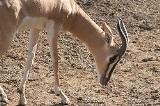
Soemmerring's Gazelle
Encyclopedia
Soemmerring's Gazelle is a gazelle
that lives in eastern Africa
.
The Soemmerring's Gazelle is a tall gazelle with tan flanks, gradually turning to white on the belly, and long black horns. They are approximately 75-90 cm (2.5–3 ft.) at the shoulder, and they weigh 35–45 kg (77-99 lb). The diet of the gazelle consists of acacia and bush leaves, grasses, and herbs. They inhabit open steppes with brush and acacia, as well as steppes with few trees, and scientists suggest that male Soemmerring's are temporarily territorial. The life span for this animal is up to 14 years.
In many parts of North Africa and the Middle East, large stone corrals were constructed to drive herds of gazelle into, making for an easy ambush. This method of hunting started in prehistoric time and continued into the early part of the twentieth century. One interesting fact is that at some point in history, a Soemmerring's gazelle population became isolated on Kebir Island in the Dahlak archipelago where the gazelle actually developed a dwarf form of the larger mainland races.
Most species of gazelle have been hunted for food over the course of history. Soemmerrings are very understudied due to their small numbers. In their former ranges, they are extinct due to over-hunting, trophies, and food. Soemmerring's and Grant's gazelles' outward appearance are so similar that they are often mistaken for each other where their ranges overlap.
Gazelle
A gazelle is any of many antelope species in the genus Gazella, or formerly considered to belong to it. Six species are included in two genera, Eudorcas and Nanger, which were formerly considered subgenera...
that lives in eastern Africa
Africa
Africa is the world's second largest and second most populous continent, after Asia. At about 30.2 million km² including adjacent islands, it covers 6% of the Earth's total surface area and 20.4% of the total land area...
.
Subspecies
- Somali Soemmerring Gazelle Nanger soemmeringii berberana
- Sudan Soemmerring Gazelle Nanger soemmeringii soemmeringii
- Borani Soemmerring Gazelle Nanger soemmeringii butteri
The Soemmerring's Gazelle is a tall gazelle with tan flanks, gradually turning to white on the belly, and long black horns. They are approximately 75-90 cm (2.5–3 ft.) at the shoulder, and they weigh 35–45 kg (77-99 lb). The diet of the gazelle consists of acacia and bush leaves, grasses, and herbs. They inhabit open steppes with brush and acacia, as well as steppes with few trees, and scientists suggest that male Soemmerring's are temporarily territorial. The life span for this animal is up to 14 years.
In many parts of North Africa and the Middle East, large stone corrals were constructed to drive herds of gazelle into, making for an easy ambush. This method of hunting started in prehistoric time and continued into the early part of the twentieth century. One interesting fact is that at some point in history, a Soemmerring's gazelle population became isolated on Kebir Island in the Dahlak archipelago where the gazelle actually developed a dwarf form of the larger mainland races.
Most species of gazelle have been hunted for food over the course of history. Soemmerrings are very understudied due to their small numbers. In their former ranges, they are extinct due to over-hunting, trophies, and food. Soemmerring's and Grant's gazelles' outward appearance are so similar that they are often mistaken for each other where their ranges overlap.

